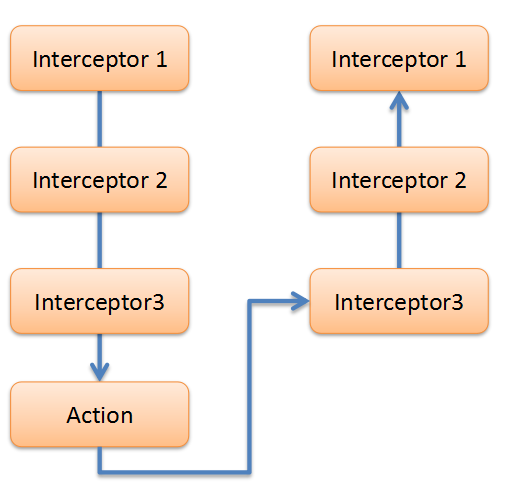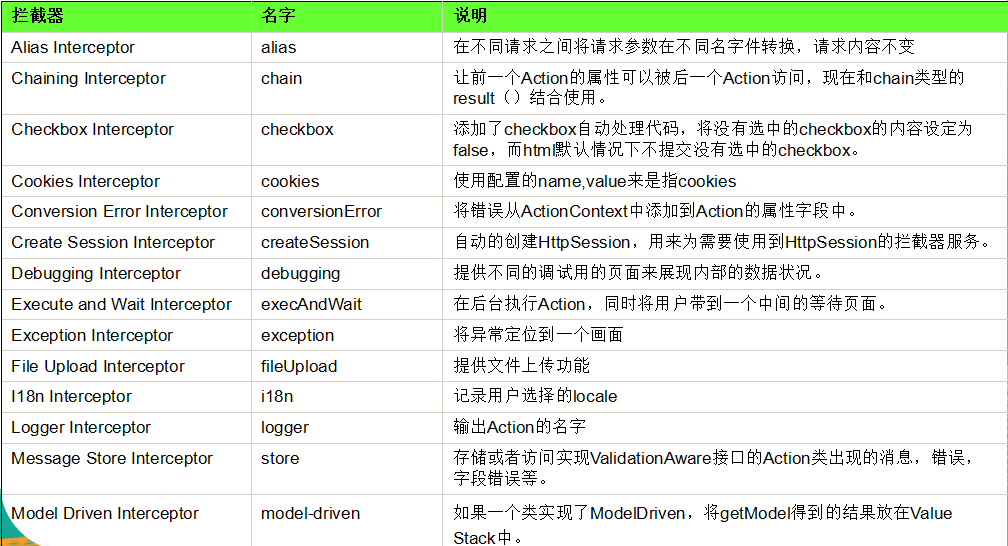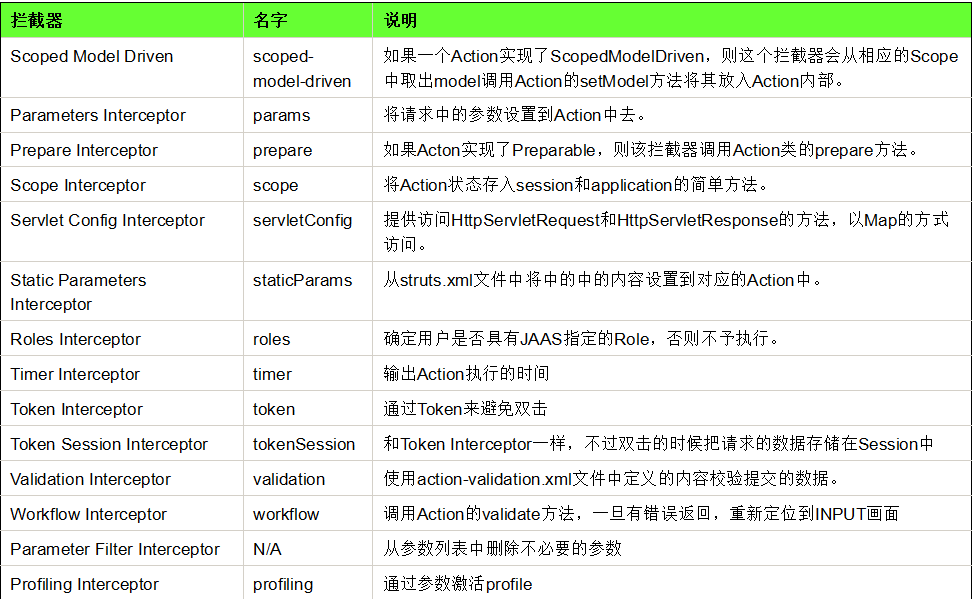本博客的目的:①总结自己的学习过程,相当于学习笔记 ②将自己的经验分享给大家,相互学习,互相交流,不可商用
内容难免出现问题,欢迎指正,交流,探讨,可以留言,也可以通过以下方式联系。
本人互联网技术爱好者,互联网技术发烧友
微博:伊直都在0221
QQ:951226918
-----------------------------------------------------------------------------------------------------------------------------------------------------------------------------------------------------------------------------------------------------------
1.Struts2 拦截器
1)拦截器(Interceptor)是 Struts 2 的核心组成部分。
2)Struts2 很多功能都是构建在拦截器基础之上的,例如文件的上传和下载、国际化、数据类型转换和数据校验等等。
3)Struts2 拦截器在访问某个 Action 方法之前或之后实施拦截
4)Struts2 拦截器是可插拔的, 拦截器是 AOP(面向切面编程) 的一种实现.
5)拦截器栈(Interceptor Stack): 将拦截器按一定的顺序联结成一条链. 在访问被拦截的方法时, Struts2 拦截器链中的拦截器就会按其之前定义的顺序被依次调用
2.strut2 的拦截器模型


3.Struts2 自带的拦截器


4.Interceptor 接口
1)每个拦截器都是实现了 接口的 Java 类:

- init: 该方法将在拦截器被创建后立即被调用, 它在拦截器的生命周期内只被调用一次. 可以在该方法中对相关资源进行必要的初始化
- interecept: 每拦截一个请求, 该方法就会被调用一次.
- destroy: 该方法将在拦截器被销毁之前被调用, 它在拦截器的生命周期内也只被调用一次.
2)Struts 会依次调用为某个 Action 而注册的每一个拦截器的 interecept 方法.
3)每次调用 interecept 方法时, Struts 会传递一个 ActionInvocation 接口的实例.
4)ActionInvocation: 代表一个给定 Action 的执行状态, 拦截器可以从该类的对象里获得与该 Action 相关联的 Action 对象和 Result 对象. 在完成拦截器自己的任务之后, 拦截器将调用 ActionInvocation 对象的 invoke 方法前进到 Action 处理流程的下一个环节
5)AbstractInterceptor :类实现了 Interceptor 接口. 并为 init, destroy 提供了一个空白的实现
5.自定义拦截器
1)定义一个拦截器的类
> 可以实现Interceptor 接口
> 继承AbstractInterceptor 抽象类
2)在struts.xml 文件配置
MyIntercepter.java
1 package com.jason.intercepter;
2
3 import org.eclipse.jdt.internal.compiler.ast.Invocation;
4
5 import com.opensymphony.xwork2.ActionInvocation;
6 import com.opensymphony.xwork2.interceptor.AbstractInterceptor;
7
8 public class MyIntercepter extends AbstractInterceptor{
9
10 /**
11 * @Fields:serialVersionUID
12 */
13 private static final long serialVersionUID = 1L;
14
15 @Override
16 public String intercept(ActionInvocation invocation) throws Exception {
17 System.out.println(" before invovation.invoke ... ");
18 String result = invocation.invoke();
19 System.out.println(" after invovation.invoke ... ");
20
21 return result;
22 }
23
24 }
Struts.xml 配置自定义拦截器 和 使用拦截器
<?xml version="1.0" encoding="UTF-8" ?> <!DOCTYPE struts PUBLIC "-//Apache Software Foundation//DTD Struts Configuration 2.3//EN" "http://struts.apache.org/dtds/struts-2.3.dtd"> <struts> <package name="default" namespace="/" extends="struts-default"> <interceptors> <interceptor name="hello" class="com.jason.intercepter.MyIntercepter"></interceptor> </interceptors> <action name="testToken" class="com.jason.upload.app.TokenAction"> <!-- <interceptor-ref name="tokenSession"></interceptor-ref> --> <interceptor-ref name="hello"></interceptor-ref> <interceptor-ref name="token"></interceptor-ref> <interceptor-ref name="defaultStack"></interceptor-ref> <result>/success.jsp</result> <result name="invalid.token">/token-error.jsp</result> </action> </package> </package>
3)注意:
自定义的拦截器中可以选择不用 ActionInvocation 的invoke() 方法。那么后序的拦截器和Action 方法不会被调用。Struts会渲染自定义拦截器 intercept方法返回值对应的result